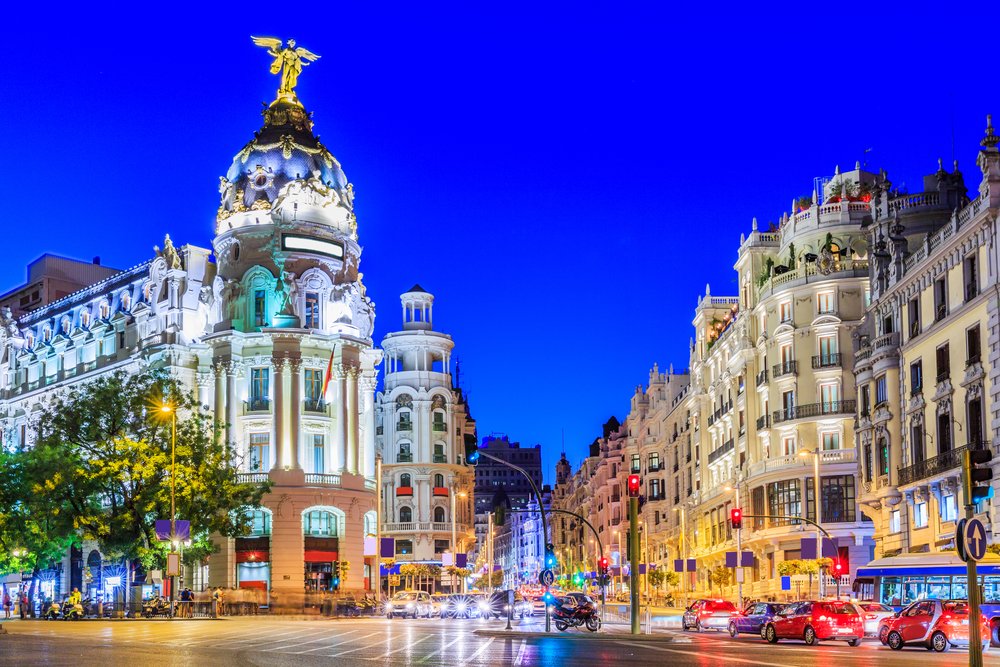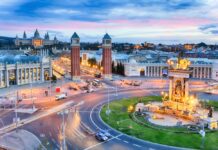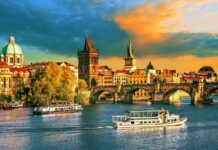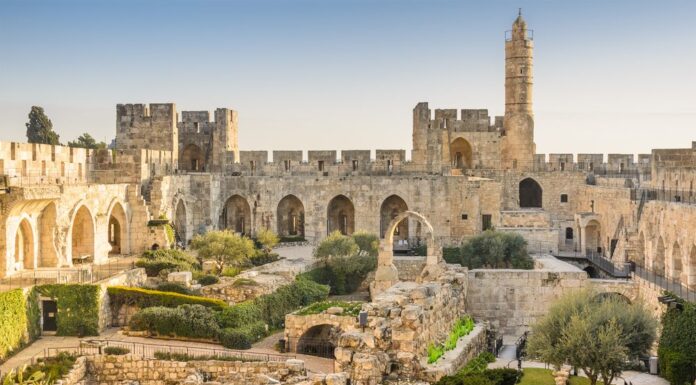From an aerial view, the posh locals that flood Madrid streets look like a speck of dust. But as you get a closer look at the city, you’d get to understand its real beauty. Behind the daily hustle and bustle, the top attractions in Madrid promise authentic experiences that make its Spanish heritage proud. Sure, it’s often overshadowed by European gems in the south and north, but its beautiful evolution makes the city worthy of endless explorations.
From the Royal Palace to the Santiago Bernabéu Stadium to its perfectly manicured gardens, Madrid has managed to water its roots while adapting to modernity. Who would have known that an affluent, artistically significant city will rise from a small, muddy village it once was? If it’s your first time traveling to Madrid, here are some of our insider travel tips.
Getting Around the Top Attractions in Madrid
If there’s anything you should pack when you travel to Madrid, it’s a good old pair of walking shoes. Getting around its main attractions — specifically its city center and historical sites — is extremely doable. So if you’re trying to cut your travel expenses, it’s time to get your leg muscles working. And oh, don’t forget to bring sunscreen if you’re traveling here in Summer. You’ll thank us later!
More good news: getting around the top attractions in Madrid is pretty cheap, especially if you have tourist passes. There are taxis, buses, and an efficient subway system in the city. For long stays, you’ll save a lot from getting 10-day passes. There are also short-stay passes for weekenders. To learn more about the city’s bus routes, download an EMT bus app.
Things to Do in Madrid
Madrid’s cultural diversity opens many travel opportunities even for the non-art enthusiast. With so many places to explore, you’ll never run out of things to do in Madrid. But to give you a better view of the main highlights here, let’s divide our guide into some of the city’s points of interest. This way, you can easily navigate around the city without sacrificing your travel preferences.
Explore Madrid’s History
Brief History: In the mid-1500s, Madrid became Spain’s capital under Felipe II’s rule. But even after so, only a few nobilities lived in the city, and its progress was quite slow. Back then, it was home to only a few monuments and sites. It was after a century later when construction of its palace commenced alongside the growth of its population. While progress was beaming during this era, a three-decade Spanish war bombarded the city, with some of its oppressors seeking the throne. Madrid’s real, unimpeded growth only began when the city adapted democracy back in the mid-1970s.
The colorful history of Madrid makes it a remarkable symbol of hope and restoration. History buff or not, its well-preserved sites are enough to tap into your imagination and convince you to immerse yourself in its rich cultural heritage. If you’re up for a history walk, here are some of the top attractions in Madrid you should visit:
Palacio Real (The Royal Palace)
The biggest royal palace in West Europe has no shortage of tapestries, porcelain, and artistic masterpieces. Built back in the mid-1700s for King Philip V, Madrid’s Royal Palace flaunts stunning neoclassical and baroque architecture. Not only was the palace home to Spanish monarchies such as Carlos III and Alfonso XIII, but it also contributes widely to the city’s historical landscape.
A rival of France’s Château de Versailles, the Royal Palace serves as a museum that invites tourists to take a look at the luxurious lifestyles of elite families. Inside its 3,000 rooms are royal collections, along with gorgeous displays of watches, frescoes, and other artworks. But if there’s anything you shouldn’t miss in this historical emblem, it’s Sabatini’s staircase, the Royal Apothecary, the Royal Chapel, and the Throne Room.
Another highlight: the Royal Armoury, which showcases the 16th-century weapons of Charles V and the string quartet of Stradivarius.
Puerto del Sol
The heart of the city and the “Kilometer Zero” that serves as a starting point for all national roadwork measurements is a famous Spanish square named Puerto del Sol. While much has changed in the area, this tourist hub was a witness of Madrid’s history, including Napoleon’s era. From Spanish resistance to the Second Republic, Puerto del Sol has seen Madrid rise from countless wars that once threatened the city.
Today, Puerto del Sol is surrounded by clothing shops and local confectionaries, and is an important site for small local traders. One of the most remarkable structures near the area is the Casa de Correos.
Templo de Debod
It may be quite surprising to find an ancient Egyptian temple in Spain, but thanks to UNESCO and Egypt, the Templo de Debod made its way to Madrid. Given as a gift to Spain for playing an important role in salvaging the Abu Simbel temples, this ancient temple was transported stone by stone from Egypt.
It was built based on its authentic orientation, and its original reliefs and carvings are well-preserved inside the temple — something you don’t usually get to see in an archeological site. History has it that the Templo de Debod was dedicated to ancient gods, Isis and Amon.
The best time to visit is during sunset when you get to see spectacular views from the temple. Around Templo de Debod are gardens, fountains, and pools that complete the magic in this top tourist site.
National Archeological Museum
Housing archeological pieces collected throughout the country, the National Archeological Museum is your gateway to century-old Spain. Some even date back before the Roman period, making this site a colorful playground for history buffs.
Some of the most impressive pieces here are the Treasure of Guarrazar, the Lady of Elche, and some 2500-year-old Iberian sculptures, which almost look new despite their age.
Dive Deep into Arts
How about Picasso, Dali, and Goya’s masterpieces as your backdrop? As one of Europe’s most powerful art capitals, Madrid won’t fall short in terms of providing you deep, artistic experiences. The city is home to numerous museums, but if you don’t have to explore it all, don’t forget to drop by Madrid’s Golden Triangle: Museo del Prado, Centro de Arte Reina Sofi, and Thyssen-Bornemisza.
Museo del Prado (Prado Museum)
There may be plenty of things to do in Madrid, but one you shouldn’t skip is a trip to the world-renowned Prado Museum. The home of baroque and renaissance masterpieces, this museum prides itself on the most popular artworks.
Some of the featured pieces here are Caravaggio’s David with Head of Goliath and Bosch’s Garden of Earthly Delights. You can also find Goya’s 14 Black Paintings hanging on its walls.
Tip: Before rushing to Prado Museum, make sure to book your ticket online unless you want to spend hours in insanely long queues. Being one of the most celebrated top attractions in Madrid, Prado Museum hosts hundreds to thousands of tourists. You can easily skip the line by making advanced reservations.
Also, the massive collection inside can be overwhelming, making it easy to get past some of the museum’s most significant works. To avoid this, grab a map and mark some of the artworks that you MUST see. You may not have time to explore all pieces, but at least you’d see the most important ones.
Centro de Arte Reina Sofi
One-third of Madrid’s Art Triangle is just as amazing as it is from the outside to the inside. Designed by prominent British architects, the Centro de Arte Reina Sofi — or simply Reina Sofia — welcomes art enthusiasts with a mesmerizing facade. Its lift towers, which are made with glass and steel shafts, serve as the entrance to the museum.
In 2005, the museum added a 30,000-square-meter back section, where you can find the famous masterpiece ‘Guernica’. Made by Pablo Picasso, Guernica commemorates the destruction in Guernica (an old Spanish name for the town of Gernika) due to a bombing in 1937. This, along with other significant art pieces, makes Reina Sofia an important home for arts and self-expression.
Museo Nacional Thyssen-Bornemisza
Museo del Prado and Reina Sofia are as equally impressive as the Museo Nacional Thyssen-Bornemisza, but they feature artworks in different ways. While the first two allow you to get a deeper perspective of an artist’s body of work, Thyssen focuses more on flaunting a wide array of artistic styles.
The private collections here include a few, or sometimes, single artworks from big iconic artists. It’s just amazing how all the big names in the art industry are gathered in just one roof — a gift given to us by Baron Hans Heinrich Thyssen-Bornemisza and Baron Heinrich Thyssen-Bornemisza who initiated the museum.
Here, you can see artworks from the 13th to the late 20th centuries, making Mannerism, Rococo, Renaissance, and other western art available for public viewing. With so many eras to explore, there’s no questioning why Thyssen is one of the top attractions in Madrid that can quench the thirst of art enthusiasts.
Stroll, Party, and People Watch
Outside its museum’s walls, Madrid manages to bring life into everyday occasions through its exciting city attractions. From tapa bars to local Terrazas to high-end Madrid hotels, the city gives plenty of room for socialization.
The plus factor: since the city isn’t as famous as Rome or Paris, you won’t see a huge number of tourists here. So if you’re wondering about the other things to do in Madrid aside from museum hopping, feel free to walk down its cobbled streets, take a sip on Spanish cocktails, and see where the crowd takes you.
Gran Via
What better way is there to explore a city than to take a walk down its famous alleyways? In Madrid’s case, Gran Via reigns supreme when it comes to giving you a deep sense of the city’s culture and entertainment. A main shopping artery lined with impressive architecture, Gran Via is a 1.3-kilometer stretch that gets you acquainted with the locals.
From signature clothing lines to family-friendly theaters, Gran Via is the perfect avenue for recreation and entertainment. At night, the street transforms into a hub for an electrifying night scene. Just like dancing to a drum beat, it allows you to let your foot loose through its assortment of local restaurants, pubs, and nightclubs.
Parque del Retiro (Buen Retiro Park) and Palacio de Cristal (Crystal Palace)
Surrounded by endless glitz and glamour, the Spanish capital can be overwhelmingly beautiful, you’d need a walk in the park. Good thing that the Parque del Retiro, which lies at the heart of the city, won’t disappoint when it comes to giving you some breathing room.
This 140-hectare, lush greenery is home to more than 15,000 trees and other plant species. Before going public in the 19th century, it was owned by the royal family. Its tree-lined pathways were initially landscaped for the 17th-century Count-Duke of Olivares, but it was only after two centuries when the park had a major makeover, thanks to Isabella II.
From the pool area in the center of the park, a pathway leads to the La Rosaleda, Jardines de Cecilio Rodríguez, and the Jardín de Don Cecilio. Aside from its immaculate gardens, the park also added one highlight in its cart: the Crystal Palace. A glass pavilion that overlooks a majestic fountain, the palace is home to prestigious artworks, making it a go-to of art enthusiasts. But if you’ve had enough of art and architecture, you can simply enjoy gazing at the park’s lakes and drinking coffee in one of its cafes.
Watch Football in its Enormous Sports Stadium
Estadio Santiago Bernabéu
Stay for a week and you’d still have a lot of things to do in Madrid, and one is watching a football game in the Estadio Santiago Bernabéu. The city takes the sport seriously, and if you’re a football fanatic, you’d be drawn to the city by its home team, Real Madrid.
Even during the off-season, you can visit this gigantic studio and enjoy a tour of its exhibits and trophy displays. The ultimate winner: the view of the field from the top of the stadium.
Where to Stay: Top Madrid Hotels
Despite being an art capital, Madrid isn’t as expensive as other European countries. Backpackers can easily find budget-friendly accommodation options here for a fun, weekend get-away.
Madrid hotels and hostels are abundant in the city. Famous high-end options include Hotel Atlantico and Catalonia Las Cortes. For low-budget Madrid hotels, you can check out Hotel Francisco and Ibis Styles Madrid Prado. The ones falling at the middle part of the spectrum are Artrip Hotel and NH Madrid Nacional.
Travel Tip: Book a hotel in advance, especially if you’re traveling to Madrid during peak season. Not only could you get amazing deals, but it will also help you create a realistic travel budget.
Final Travel Tips
Did you know that day drinking and siesta are a norm in Madrid? When traveling around the city, a few family-run shops close between 2 PM to 5 PM, so don’t be surprised if you see some establishments temporarily closing during these times.
Main point: When exploring the top attractions in Madrid, it pays to learn a little Spanish, and of course, a bit more about the city’s customs. This way, you’d know what to expect from the city, and you can plan your travel accordingly.
But hey, don’t worry. Aside from adjusting to the afternoon naps, it’s easy to fall in love with Madrid, especially if you’re drinking cocktails from its beautiful Terrazas. So take a stroll, dine out, and savor the experience. Because when you’re here, you’d never run out of things to explore.










[…] and breathtaking place in the whole of Madrid, there’s no leaving the city without checking The Royal Palace of Madrid. Known as the official home of Spain’s monarchs, the place is now open for public […]
Comments are closed.